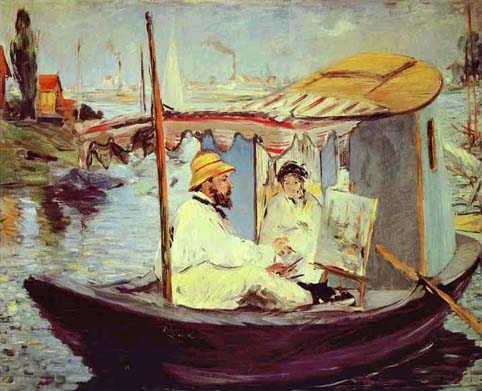As a young man, French painter Claude Monet (1840-1926) abandoned the traditional approach to painting – standing in a studio, copying the old masters – in favor of painting scenes in the open air. Monet delighted in the interplay of color and light found in nature. He loved to paint in his garden at Argenteuil, a pretty, bustling village just outside of Paris.
A spectacular stretch of the Seine, where the river reached its widest and deepest points, ran through Argenteuil. Shortly after moving there in 1871, Monet bought a boat and converted it into a floating studio. He kept it moored near his home and used it to get a vista of the riverbank from the water.

"Claude Monet Painting on His Studio Boat," by Édouard Manet, 1874. The shadowy female figure sitting with the artist is his wife and model Camille Doncieux Monet.
Living with Monet at Argenteuil were his wife Camille Doncieux and their son Jean. Camille had been Monet’s model since they met in 1865. The couple lived in depressing poverty.
Right up to her death, Camille posed for her husband’s paintings, more often than not, appearing as an indistinct female figure in a rural landscape.
Sometimes Camille has her back to the observer; othertimes her face is veiled or hidden.
Camille was quite the devoted model. In Monet’s painting, “Women in a Garden” (1866-67), she posed for all four female figures!
Camille was so cooperative that she freely posed for Monet’s painter friends, too.

"The Monet Family in Their Garden at Argenteuil," by Édouard Manet, 1874. Camille and son Jean relax while Claude Monet tends his garden.
Auguste Renoir painted Madame Monet – known as “La Monette” – several times.
Here is one of the rare times her husband paints her face clearly enough to distinguish her features, particularly her huge and sad-looking eyes. She often looks melancholy.
In 1876, Camille Monet fell ill with what is believed to have been cervical cancer. In “Camille Holding a Posy of Violets,” below, one can see the toll the disease has had on her health. She looks tired, older, and pale. It is speculated that her expression betrays her disgust with her husband who, by then, was openly carrying on a flirtation with their mutual friend, Alice Hoschede. Alice and her two children shared a house with the Monets.
In 1878, Camille gave birth to a second son, Michel. Her health was dangerously weakened. Although Monet was not as attentive as he could have been to his wife, he loved Camille and was devastated that she was dying. For a time, he lost the desire to paint.
Finally Camille’s long suffering came to an end on September 5, 1879. Monet was grief-stricken. But even his internal pain could not stifle his passion to paint. Camille – his model-wife – was his muse, his inspiration to paint. At her deathbed, he took out his paints and painted her last portrait.
“I caught myself watching her tragic forehead,” Monet wrote afterwards to a friend, “almost mechanically observing the sequence of changing colours that death was imposing on her rigid face. Blue, yellow, grey and so on… my reflexes compelled me to take unconscious action in spite of myself.”
Little is known about Camille Doncieux Monet (1847-1879) mainly because Monet’s mistress and second wife, Alice Hoschede, was so jealous of Camille that she demanded that Monet destroy all mementos – letters, photos – anything – that attested to Camille’s very existence. (1)
(1) Gedo, Mary Mathews. Monet and His Muse: Camille Monet in the Artist’s Life. Chicago: University of Chicago Press, 2010.



























